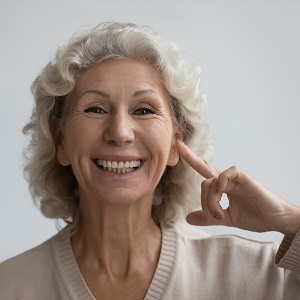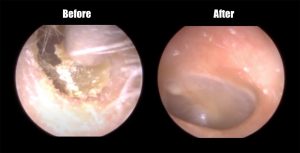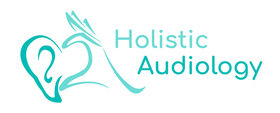Earwax can often get trapped in the ear by:
- Excessive hair in the ear canals
- Small, narrow or bendy ear canals
- Use of ear buds, ear plugs and hearing aids
- Reduced natural outward migration of ear cells with age
Some people also may also produce excessive wax. Earwax build-up and impaction is present in up to 57% of older people and in 5% of younger adults.

Ears are naturally ‘self-cleaning’
The cells in your ear canals naturally self-clean through slowly shuffling earwax and other dirt outwards away from the eardrum, much like a conveyor belt. Jaw movements during talking and chewing also help with the cells migrating outwards in this self-cleaning process. In a normal properly working ear, you only need to gently wipe excess earwax from your outer ear with a face towel.
Perils of Earwax Self Remedies
The use of cotton buds, bobby pins and other foreign objects to clean your ears, in fact pushes earwax further into your ear canals. This can cause earwax impaction. Using these objects can also damage the lining of your ear canal, causing infection, hearing loss and risk of puncturing your eardrum. Remember the mantra: “never put anything smaller than your elbow into your ear” is just as relevant today.
A non-medical procedure commonly available is ear candling. Ear candling involves burning a hollow candle that is placed in the ear canal. There is significant medical evidence of ear injuries resulting from ear candling; such as, burns, blockage of the ear canal from the burnt candle wax and debris requiring surgery, rupture of the ear drum, bleeding, infection and hearing loss. Besides being ineffective, ear candling is dangerous. Another common home remedy is self-syringing, which is also not recommended due to the potential danger of self-inflicted ear trauma.
Benefits of Professional Earwax Removal
The safest way to remove earwax from your ears is by a trained and accredited earwax removal health professional.
Earwax needs to be professionally removed, especially when you have associated symptoms. Symptoms of impacted or excessive earwax can be the same as those of ear infections and fluid build-up behind the eardrum.
The only way of determining if you have excessive earwax is to have your ears professionally examined. Earwax blocking the view to your eardrum also needs to be professionally removed, as it prevents proper diagnosis of your ear health and hearing.
Professional Earwax Removal Techniques
 The most appropriate and effective earwax removal technique used is dependent on the type of earwax (wet or dry) present, the degree of earwax impaction and amount of blockage in the ear canal.
The most appropriate and effective earwax removal technique used is dependent on the type of earwax (wet or dry) present, the degree of earwax impaction and amount of blockage in the ear canal.
Accredited earwax removal health professionals are trained to perform all three earwax cleaning methods and also have in-depth knowledge of the use of cerumelytics (earwax softeners).
In some cases, a combination of earwax cleaning methods and the use of earwax softeners is required to achieve the most effective result.
Irrigation or Syringing is the most common method used by GPs to date. Irrigation removes earwax with low pressurised water delivered via a syringe. It has been effective in removing larger more occluding clumps of harder earwax. Contraindications to syringing include previous ear infections, tinnitus, past eardrum perforation, ear surgery, reduced immunity leading to greater risk of infection, narrow and bendy canals that can trap water and large masses of dead skin. Complications may occur following syringing in some clients, such as experiencing tinnitus and vertigo. Syringing can damage the delicate skin in the ears causing ear canal trauma and eardrum perforation. Water retained in the ear canal poses an increased risk of infection.
Mechanical removal or Curettage involves using earwax loops to gently remove earwax. Curettage is most effective in dealing with pieces of dry earwax and flaky skin. The circular wax loop has no sharp edges for safety and allows for earwax cleaning close to the canal walls. Medical grade forceps may also be used to extract pieces of debris. The treatment is done using a specialised headlamp (Vorotek O Scope) which provides bright, clear and magnified vision deep into the ear canal. It is a dry method and does not expose the ear to moisture, hence the risk of infection is reduced. It may be an uncomfortable and/or painful procedure for some people. Curettage is often the alternative earwax removal method to syringing.
Micro-suction is a more modern earwax removal technique. It uses a specialised medical grade micro-suction machine to gently vacuum out earwax. The procedure is performed under magnification via specialised headlamp or microscope. Microsuctioning is a safe and effective earwax cleaning method, especially for removing deep and/or stubborn earwax. Some people may find the noise from the suction wand causes discomfort, though there is no evidence that the noise level permanently affects hearing. Complications may arise, with the most common complaints following microsuctioning being vertigo or dizziness, temporary reduction in hearing and/or experience of tinnitus. For safety, it is crucial that clients keep their head still during the procedure, therefore it is not recommended for younger children or those unable to maintain a fixed head position.
Cerumenolytics (earwax softeners) may also be used during earwax removal treatment to help soften and/or disperse more solidified plugs of earwax. Cerumenolytics are used to complement the earwax removal treatment. They may be recommended as a routine management option post treatment, if suitable.
You should not use earwax softeners if you have any of the following: perforated eardrum, have grommets (ventilation tubes), outer or middle ear infections, irritation or rashes in the ear canals and/or outer ears, or is allergic to any of the compounds in the earwax softener. Earwax softeners should also be used with caution in young children.
Holistic Audiology ~ Accredited Earwax Removal Hearing Professional
If you suspect earwax blockage, have noticed any ear related symptoms or you are worried about your hearing, please contact us for a consultation to determine if there is earwax blockage that requires professional earwax removal. Alternatively, please consult your doctor (GP), Ear Nose and Throat specialist (ENT) or hearing professional for an assessment of your ear status.
Experience Holistic Audiology
REFERENCES:
Audiology Associates, UK. (2017). Epic skin and ear wax removal using Jobson horne, suction and crocodile forceps – Ep 23. Youtube. https://www.youtube.com/watch?v=4eP165WHdhs
Bird, S. (2003). The potential pitfalls of ear syringing: Minimising the risks. Australian Family Physician. 32(3):150-1. PMID: 12666354. Retrieved from https://pubmed.ncbi.nlm.nih.gov/12666354/
Clark, J., Beck, D.L., Kutz, W. (2010). Ear Candles and Candling: Ineffective and Dangerous. American Academy of Audiology – Editorial. https://www.audiology.org/ear-candles-and-candling-ineffective-and-dangerous/
Government of Canada. (n.d.). Ear candling. Retrieved from https://www.canada.ca/en/health-canada/services/medical-procedures/ear-candling.html
Olson, C. (2018). Do Ear Candles Work To Remove Earwax? | Ear Candling Proof! – YouTube. https://www.youtube.com/watch?v=CQJt1LWH32k
Poulton, S., Yau, S., Anderson, D., Bennett, D. (2015). Ear wax management. Australian Family Physician. 44(10):731-734. https://www.researchgate.net/publication/283049038_Ear_wax_management
Prowse, S.J., Milla, O. (2014). Aural microsuction for wax impaction: Survey of efficacy and patient perception. Journal of Laryngology and Otology. 128:621–25. doi: 10.1017/S0022215114000796. Retrieved from https://pubmed.ncbi.nlm.nih.gov/25017385/
Snelling, J.D., Smithard, A., Waddell A. (2009). Noise levels generated within the external auditory canal during microsuction aural toilet and the effect o,n hearing: A prospective controlled series. Clinical Otolaryngology. 34:21–25. https://doi.org/10.1111/j.1749-4486.2008.01841.x
